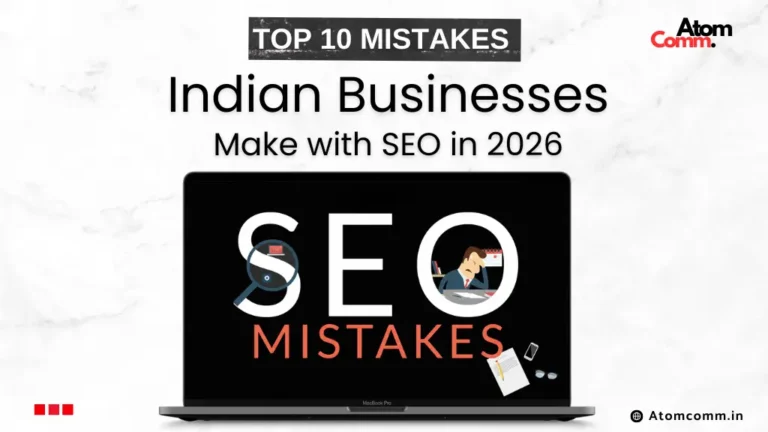Top 10 Mistakes Indian Businesses Make with SEO in 2026
Indian businesses often fall into the same SEO traps — outdated tactics, weak content, and ignoring user intent. This blog reveals the top 10 SEO mistakes brands make in 2026 and how to fix them for sustainable growth.
Ignoring Local SEO
Overlooking Mobile Optimization
Producing AI-Generated, Low-Quality

The financial technology (fintech) industry is one of the fastest-growing sectors in the world. With new startups entering the space almost daily and established banks pivoting to digital-first solutions, the competition for visibility, trust, and customer loyalty is fierce.
In such a crowded market, a generic PR approach simply won’t cut it. This is where specialized fintech PR agencies step in — firms that understand both the nuances of finance and the storytelling power of technology.
1. Ignoring Local SEO
Many Indian companies still fail to optimize for local search, even when their customers are searching within specific cities or regions. Local SEO helps your business show up in “near me” searches and Google Maps listings.
For example, if you run a salon in Pune or a real estate firm in Hyderabad, you need location-specific landing pages and verified Google Business Profiles. Without this, your brand gets buried beneath competitors who’ve mastered local optimization.
Learn more about local SEO best practices from Search Engine Journal India.
2. Overlooking Mobile Optimization
In 2026, over 85% of internet users in India browse on mobile devices. Yet, many websites still load slowly or display poorly on mobile screens. Google’s mobile-first indexing means that your mobile version determines how your site ranks.
If your pages aren’t responsive or optimized for mobile UX, you’re handing rankings to your competitors.
3. Neglecting Voice Search
With voice assistants like Alexa, Siri, and Google Assistant dominating household and smartphone use, voice search is now a critical SEO factor. Brands that fail to optimize for conversational queries (“Where’s the nearest co-working space in Bengaluru?”) miss massive organic traffic.
In 2026, Indian businesses need to focus on natural-language keywords and structured data to capture this growing segment.
4. Focusing Only on Keywords, Not Intent
Keyword stuffing is an old habit that refuses to die. Businesses still chase search terms instead of understanding what users actually want.
Modern SEO revolves around search intent — informational, navigational, commercial, or transactional. Brands that align their content with user intent see better engagement and higher conversions.
5. Producing AI-Generated, Low-Quality Content
AI tools have made content creation faster — but not always better. Many Indian businesses rely heavily on automated content that lacks originality and depth.
In 2026, Google’s algorithms prioritize E-E-A-T (Experience, Expertise, Authoritativeness, and Trustworthiness). Businesses need real human insight and verified expertise in their content, not mass-produced AI fluff.
6. Ignoring Technical SEO
Technical SEO isn’t glamorous, but it’s the foundation of search visibility. Broken links, slow load times, duplicate pages, and poor crawlability can cripple your rankings.
Regular site audits using tools like Ahrefs or SEMrush can help identify these issues before they impact performance.
7. Forgetting About Backlink Quality
Link-building remains one of Google’s strongest ranking signals — but many businesses still chase volume over quality. Purchasing backlinks or using link farms may deliver short-term gains, but they lead to penalties in the long run.
Instead, focus on earning backlinks from trusted media, niche blogs, and industry directories that boost credibility and domain authority.
8. Skipping Content Refresh and Updates
Content isn’t a one-time effort. Many brands publish and forget. But in 2026, freshness matters more than ever.
Updating older articles with new data, case studies, or trends keeps them relevant in Google’s eyes and increases visibility.
For instance, a 2022 article about “Digital Marketing Trends” needs fresh 2026 insights to remain competitive.
9. Underestimating the Power of Analytics
Data-driven SEO separates leaders from laggards. Many Indian companies still rely on assumptions instead of real analytics.
Tools like Google Search Console and Google Analytics 4 provide valuable insights into user behavior, click-through rates, and conversion metrics — all essential for refining SEO strategy.
10. Treating SEO as a One-Time Project
Perhaps the biggest mistake of all is treating SEO as a campaign — not a continuous process. Search algorithms evolve monthly, user behavior shifts, and competitors adapt.
Sustainable SEO requires consistent monitoring, fresh content, and ongoing optimization. It’s a long-term investment, not a one-time fix.
Proof & Outcomes
60% higher investor visibility through targeted media coverage and thought leadership.
Global brand mentions across leading fintech and business publications.
Faster funding traction, with startups securing new investor rounds within months of PR activation.
FAQs
Typically, it takes 4–6 months to see measurable improvements in rankings and traffic. However, the timeline depends on competition, content quality, and domain authority.
Absolutely. Local SEO is particularly powerful for small Indian businesses, helping them appear in neighborhood searches and attract nearby customers.
Yes. AI helps in keyword research, content optimization, and predictive analytics — but human creativity and expertise remain essential for credibility and engagement.
You should review and adjust your SEO plan at least every quarter to align with algorithm changes and market trends.
Book a Free PR Strategy Session
Tell us a bit about your brand and goals. We’ll share a tailored press plan and timeline.
